Who in the world doesn’t love the comforting and soothing feel of sitting in an AC room?
An air conditioner, after all, has been the most effective choice to isolate yourself from the outside weather. However, choosing an air conditioner for your room may look tempting; at the same time, it’s pretty daunting if you take factors like energy efficiency into consideration (which you should). In that case, there is no need to worry.
As we advance, we’ll look at various aspects that decide the extent of Tonnage, ISEER, EER, COP, and BEE Star Ratings for AC in 2024. Read this article to the very end to learn how to pick the most energy-efficient AC with the highest ISEER rating for your home. To understand ISEER, it is necessary to know about tonnage and BTU.
What is Tonnage (Ton) of AC?
When purchasing an AC for your space, you may encounter different tonnage values for other ACs, typically ranging from 0.5 tons to 5.0 tons for regular use. For starters, it has nothing to do with the weight of an AC; it simply can’t weigh in tons anyway. It is instead the cooling capacity of an AC.
The tonnage of an AC is the most important and straightforward deciding factor for the energy efficiency of an AC. It plays a significant role in choosing the right AC for various room sizes. That being said, selecting the wrong tonnage may result in unnecessary energy loss, or, for the most part, your AC may not be able to cool your space adequately.
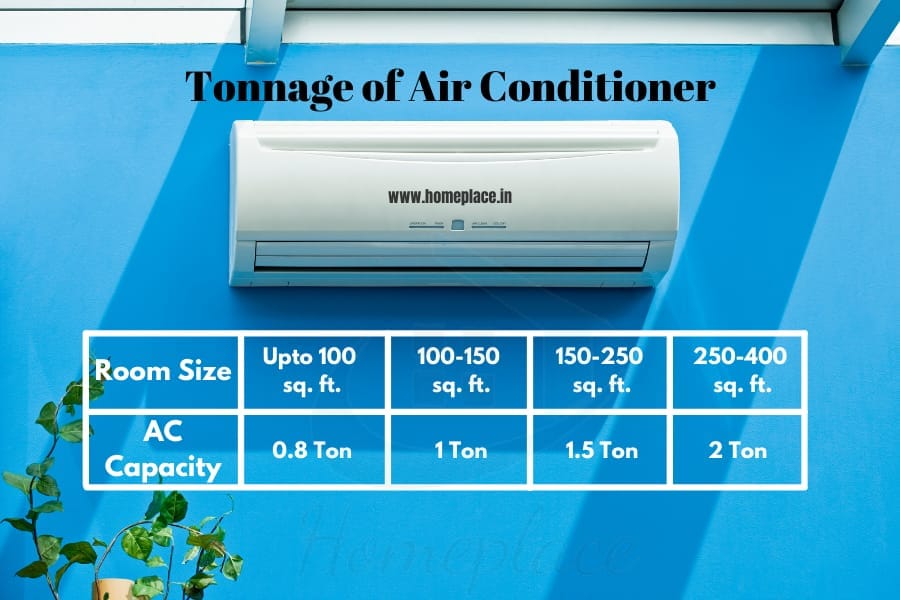
How to select the correct tonnage for your AC?
Choosing the right tonnage for your AC is more important than you think. You may feel more tonnage will result in fast cooling (which is true fundamentally); things work quite differently in reality. The selection of air conditioners is based on a principle called the Goldilocks principle. According to this concept, you need just the right tonnage for your AC, not too low and not too high.
As mentioned above, the idea of buying an AC with the highest tonnage may look tempting, but it’s not. Installing a 5-ton AC in a room that requires just 1.5 tons will put an extra load on the mechanical components of your AC.
Meanwhile, your AC will short-cycle, making it turn off too early, resulting in an operation that’s highly inefficient and damaging to the system. As a result, your AC will require abnormally frequent repairs. And if that wasn’t enough, skyrocketing electricity bills are the final nail in the coffin for your “more tonnage = better performance” idea. In the case of an AC with a lower tonnage, it will struggle to cool your space.
So, how to know the optimal AC tonnage for your room?
As a rule of thumb, you will need 0.0016 tons of AC per square foot. Simply put, you need 1 ton of AC for every 600 square feet of area. If your space follows this criterion, a 1-ton AC unit will be sufficient. However, take these values with a pinch of salt since these are only general estimations.
There’s an alternative and more effective method that allows you to calculate the optimal tonnage based on the area of your space. Multiply the area of your room (in square feet) by 25 and divide that number by 12,000. This should give you an estimate of the tonnage you’ll require from your AC to cool your space adequately.
What is BTU?
The full form of BTU is the British Thermal Unit. It is used to measure the cooling capacity of an air conditioner. By definition, BTU is the amount of heat energy required to raise the temperature by 1 degree Fahrenheit of 1 pound of water.
Precisely, in the case of air conditioners, the cooling capacity of an air conditioner is measured as the amount of heat energy (in BTUs) it can remove from the area in an hour.
You measure the tonnage of an AC in BTUs where 1 BTU is equivalent to 1055.06 joules of energy. A 1 Ton AC can remove 12,000 BTUs of heat in one hour.
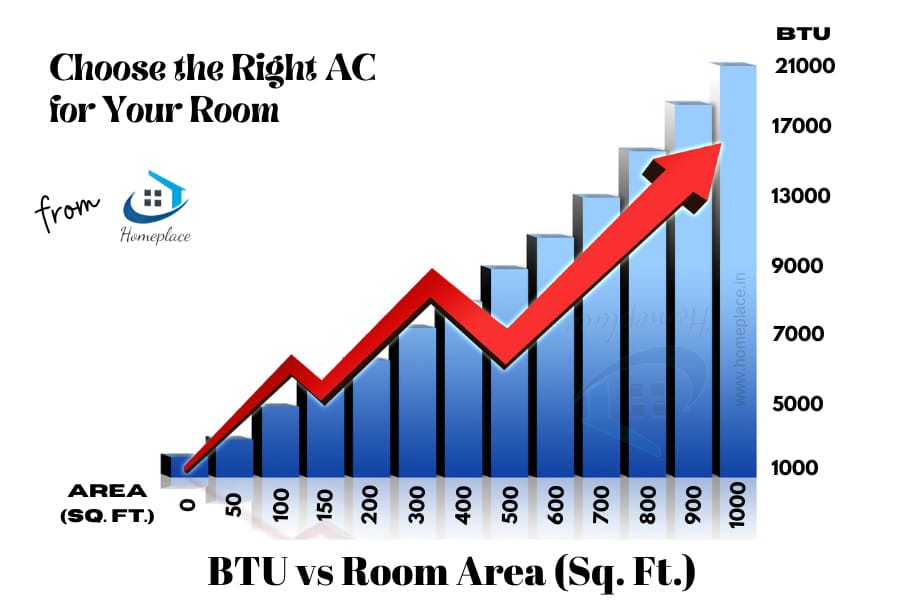
Whether you should go for an AC with the highest BTU-dissipation capacity (highest tonnage) is a question we’ve already answered in the former section.
How to Calculate the Energy Efficiency of Air Conditioners?
While calculating the power consumption is easy, the calculation of the efficiency involves more factors. The efficiency of an AC is how effectively your AC utilizes power to produce the desired cooling effect. An AC that consumes less energy while maintaining its efficacy is said to be highly efficient.
That’s why we have a BEE-devised ‘star rating’ for ACs and various other electrical appliances. The star rating of an AC that determines the efficiency of an AC acts as a thumb rule for non-technical customers. The higher the star rating of an AC, the higher its efficiency.
However, in technical terms, various ratings like the ISEER, EER, SEER, and BEE star ratings of an AC allow you to precisely measure its efficiency.
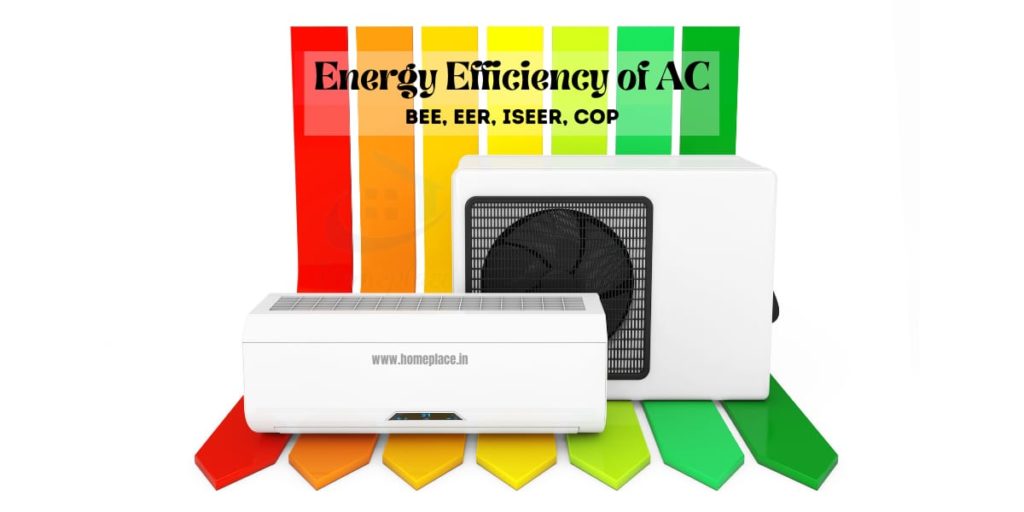
What are EER and SEER Ratings?
If you take a brief look at the specifications of your AC, you will find an EER rating associated with your AC unit. The full form of EER is Energy Efficiency Ratio. This rating typically ranges from 7.8 to 15 in modern air conditioners. Calculating the EER rating associated with your air conditioner is a pretty straightforward process. All you have to do is divide the BTUs so that your AC can dissipate by the wattage of your AC unit.
EER = (amount of heat removed/ power consumption)/ hour
For example, suppose you have a 1-ton AC that can dissipate roughly about 12,000 BTUs in an hour, having a wattage of 1200 Watts. The EER rating, in this case, will be 10, which is neither too high nor too low. The number will increase as you lower down the wattage and increase the BTUs. As you might’ve guessed, the EER rating associated with an AC unit runs parallel to the overall efficiency of the AC. The higher the EER rating of your AC, the higher its efficiency, which translates into lower electricity bills and a better cooling effect.
With all that’s said, the EER rating is known (and proved) to be less precise regarding real-world usage. That’s primarily because of the few temperature and humidity constraints that must be met to calculate the EER rating precisely. These constraints are as follows:
- The indoor temperature should be around 80°F.
- The outdoor temperature should be around 95°F.
- Relative humidity must be at 50%.
However, such conditions can’t be met in the real world, making the EER rating highly inaccurate in places where these conditions are not met fully. That’s why we had to introduce an additional metric named SEER which is the short form of Seasonal Energy Efficiency Ratio. It is used to overcome this limitation of EER.
Why is SEER more precise compared to EER?
Unlike EER, which requires fixed outdoor and indoor temperatures, SEER is calculated with varying outdoor temperatures. Furthermore, while keeping indoor temperatures constant, outdoor temperatures can vary between 60F to 100F. It allows room for temperature differences between various seasons throughout the year, especially the summer season.
Moreover, calculating SEER ensures the efficiency of the AC is averaged out throughout the year, thereby providing you with a more precise energy efficiency rating. However, calculating SEER follows the same approach we discussed earlier. You divide the BTUs by the wattage of the AC to get the SEER rating, and it’s just that this rating will need to be calculated concerning different temperatures.
what is ISEER Rating?
ISEER rating is the India-specific version of the SEER rating and stands for the Indian Seasonal Energy Efficiency Ratio. It can be calculated as-
ISEER = Cooling seasonal total load (CSTL) / Cooling seasonal energy consumption (CSEC)
An ISEER rating of 4.5 is considered average; you should avoid purchasing ACs with a lower than this value. ISEER rating of more than 5 is a potential sign that your AC is very efficient. However, there are very few ACs that manage to get an ISEER rating of 5 or above.
In the case of a 1.5-ton AC, an ISEER rating of 5.2 means that the AC can remove approximately 18,000 BTUs of heat while consuming just 1325 watts of power. Such ACs are exceptionally efficient when it comes to saving energy and purchasing them is a no-brainer.
Highest ISEER Rating AC in India 2024






LG PS-Q20SNZE and Daikin FTKM50U are the highest ISEER rating ACs in India. Both come with an ISEER of 5.2 and a capacity of 1.5 tons adhering to the BEE guidelines for a 5-star AC.
Among these three options, we highly recommend LG’s air conditioner because it consumes the least energy and produces minimal noise while having the highest ISEER rating. Apart from LG and Daikin, the next close option is Panasonic’s CS/CU-HU18YKYF, with an ISEER rating of 4.6.
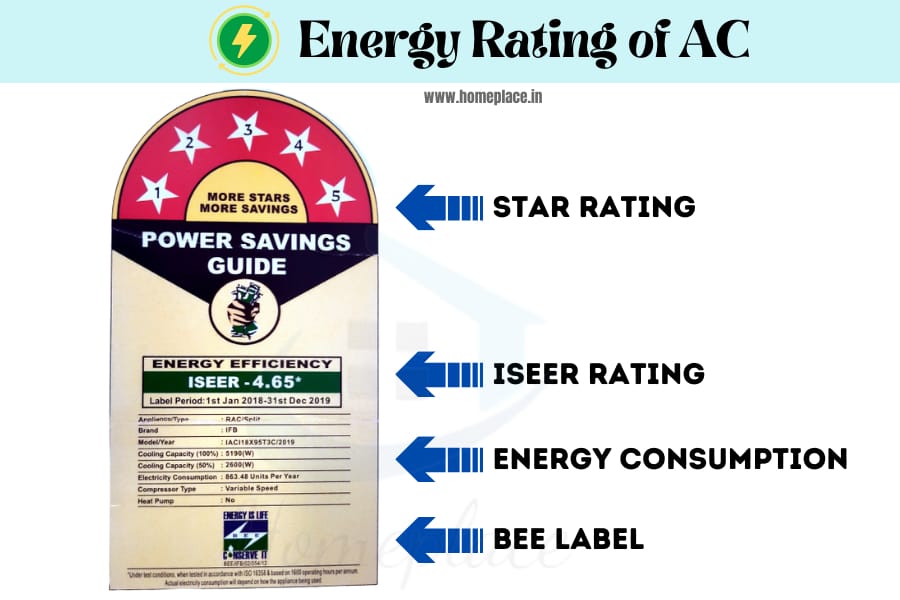
ISEER vs EER
The ISEER rating is used to provide star ratings (that we’ve already discussed) to different models of ACs. Here are the differences between ISEER and EER-
| Point of Difference | ISEER | EER |
|---|---|---|
| What is it? | The ratio of seasonal total cooling output to power consumption. | The ratio of cooling output and energy used at a particular season. |
| Approval | Approved by the Indian Government. | Acknowledged internationally. |
| Seasonality | It depends on the seasonal temperature and humidity. | It does not take seasonal parameters into account. |
| Applicability | Applicable for inverter compressors. | Suitable for non-inverter compressors. |
| Accuracy | ISEER is more accurate because of the seasonal factors. | EER is less accurate than ISEER. |
What is BEE Star Rating?
While shopping for electrical appliances such as ACs and refrigerators, you must’ve noticed stickers depicting star ratings for appliances. These stickers are known as BEE star labels and display a star rating between 1 to 5.
The Bureau of Energy Efficiency (BEE) devised this star rating for ACs and other electrical appliances to make the task of determining the efficiency of an AC as straightforward as possible. The BEE rating associated with an AC unit directly depicts its efficiency. Ranging from 1-5 stars, the BEE rating is an energy efficiency standard that’s mandatory for most electrical appliances sold in India.
An appliance with a 5-star rating is more efficient than an appliance with a 2 or 3-star rating. However, is it always a good idea to get the AC with the highest star rating? Well, maybe not!
BEE Star Rating 2024 For Split AC As Per Third Amendment 4634 (E) To Notification 2528(E)
| Star Rating | ISEER Band |
|---|---|
| 1 Star | 3.10-3.29 |
| 2 Star | 3.30-3.49 |
| 3 Star | 3.50-3.99 |
| 4 Star | 4.00-4.49 |
| 5 Star | ≥4.50 |
| Star Rating | ISEER Band |
|---|---|
| 1 Star | 3.30-3.49 |
| 2 Star | 3.50-3.79 |
| 3 Star | 3.80-4.39 |
| 4 Star | 4.40-4.99 |
| 5 Star | ≥5.00 |
What is the importance of the BEE rating?
An AC with a 5-star rating will consume less power, produce a better cooling effect, and be environment-friendly. However, higher ratings do come with a price. Whether you need an AC with a 5-star rating depends on your location and climate. If you live in hot and humid weather, your AC will have to function more than 12-15 hours per day. In that case, a 5-star rated AC will be ideal; it will cool your room faster while keeping the electricity bills in check.
However, you don’t need a 5-star rated AC if you live in a relatively cooler place where you’ll only require an AC in the summer seasons. A 3-star AC will do the trick, no need to spend extra money on more stars. In any case, avoid going for ACs with a BEE rating lower than 3 stars.
Can you trust BEE ratings?
The Bureau of Energy Efficiency gets all the data from the manufacturers themselves, although not directly. The newly-launched electrical appliances such as ACs are tested in a lab accredited by NABL (National Accreditation Board for Testing and Calibration Laboratories). The lab then sends these results to BEE to devise a star rating for that particular appliance.
In any case, if you ever find that the real-world efficiency of your recently-purchased AC doesn’t justify its star rating, you can submit a written complaint to BEE. The BEE will then test the product again, and if issues are to be found, the manufacturer will be required to remove the product from the market. However, such a case is sporadic. Most often, the efficiency of your AC will justify its BEE rating.
After all, brands have a reputation to maintain. Meanwhile, don’t put your entire trust in BEE labels; you have to consider multiple factors if you’re buying an AC solely based on its BEE rating.
Things to check to choose an AC based on its BEE Rating
The year when the appliance was rated
The BEE star label depicts more than just the appliance’s BEE rating. It also mentions the year when the appliance was rated, which is much more crucial than you may think. Recently in 2016, BEE updated its star label system to be based on the EER rating. Since BEE keeps revising the star label system, knowing when the appliance (AC) was rated can prevent bad choices. It’s always best to go for the AC that has been recently rated.
Electricity Consumption per Year
Since saving energy is your primary concern, blindly going with the highest-rated AC will be a mistake. A 5-star window AC may consume more power than a 3-star split AC. In that case, the BEE label also mentions the units of electricity the appliance will consume in 1 year. This should give you a concrete idea of whether you’re choosing the most energy-efficient AC.
What is the Coefficient of Performance (COP)?
Like EER or SEER, the Coefficient of Performance (COP) is another metric used to describe the efficiency of an air conditioner. COP is the ratio of heat output from the condenser to the power supplied to the compressor. In other words-
COP = Cooling capcity of the AC/ Electrical energy input
For example, if your appliance generates 2kW of heat by utilizing 1kW electrical input, the COP of that appliance will be 2. Similar to the EER or SEER rating, the COP of an AC is directly proportional to its efficiency. The higher the COP of the AC, the higher will be its efficiency. COP can also be converted to EER as COP= 0.293*EER.
However, you may not find any COP value associated with an AC unit, not even in the specifications sheet. Popular and widely-used metrics such as BEE rating (star rating) and EER/SEER rating are derived from the COP. That’s why manufacturers tend not to show the COP of an AC directly to the customers to avoid confusion.
What is SCOP?
Similar to the EER rating, COP also has the demerit of fixed temperature constraints. That’s where SCOP or Seasonal Coefficient of Performance comes into play. Unlike COP, SCOP is a more precise metric to measure the efficiency of an AC. SCOP enables us to measure the energy efficiency of an AC in winter and summer seasons alike.
The SCOP value associated with an AC gives a realistic value of its energy efficiency in practical usage. Although being an effective measure to determine the efficiency of an AC, you won’t find a SCOP ratio associated with any AC in the market. That’s because manufacturers don’t find it very useful to stick so many energy-efficiency ratings on their appliances.
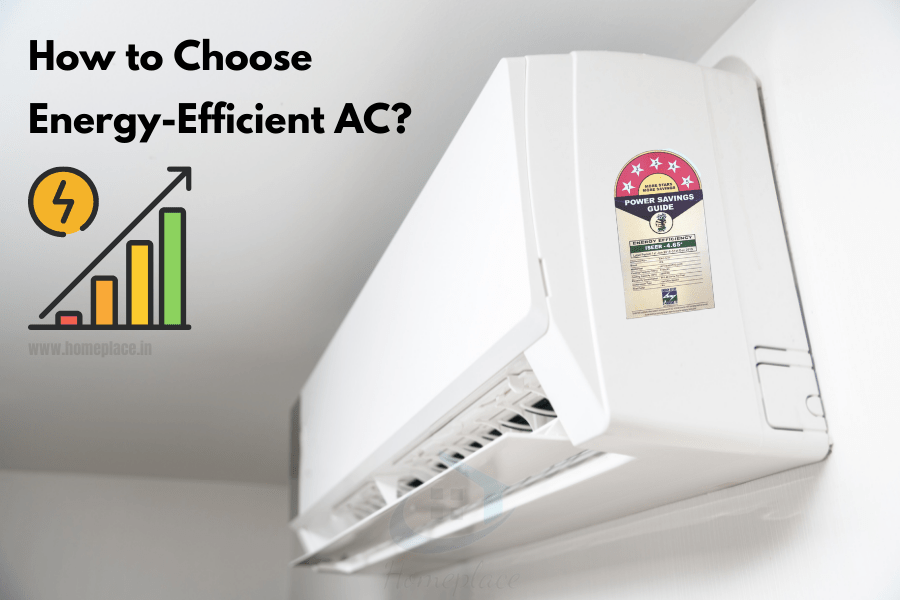
How to Choose an Energy-efficient Air Conditioner in 2024?
These 10 tips will help you choose the most energy-efficient AC for your space-
1. Choose the Right Size
Being more extensive and more powerful doesn’t always translate to better performance, at least not in the case of air conditioners. Choosing the right size is more important than you think. While a small-sized AC won’t properly cool your room, an oversized AC will result in short cycling and induce dampness in the room. As a result, your AC may demand abnormally frequent repairs and services.
2. Temperature Sensor with Programmable Temperature Settings is a Must
Programmable temperature settings with temperature sensors will allow you to set custom temperatures based on your comfort. This will prevent unnecessary loss of energy while prolonging the life of your AC. However, most modern ACs (even window ACs) have such basic features.
3. Look for Energy-saving Settings
Most modern ACs have an in-built temperature sensor that allows togging the energy-saving setting on your AC. It would be best to always look for temperature sensors and this energy-saving setting while purchasing an AC. This feature will allow you to schedule your AC to turn off automatically when a certain temperature threshold is reached, keeping your monthly electricity bills in check.
4. Look for Higher EER/SEER Ratings
EER and SEER stand for Energy Efficiency Rating and Seasonal Energy Efficiency Rating, respectively. Both of these are used to measure the efficiency of the AC, with SEER being more precise and accurate. It would help if you always looked for an EER or SEER rating higher than 9. An AC with a higher EER/SEER rating depicts that the particular AC generates a better cooling effect while maintaining minimum power usage.
5. Go for a Smart Air Conditioner
The energy-saving possibilities with smart air conditioners are limitless. You can utilize a virtual assistant like Alexa or Google Assistant to fully control your AC, provided that your AC has wifi connectivity. Smart air conditioners allow you to fine-tune your usage, effectively increasing the overall energy efficiency of your AC.
6. Prefer Purchasing an Inverter AC
An inverter AC can turn out to be more beneficial than you think, thanks to an entirely different and efficient operation. An inverter AC offers better and more consistent cooling, silent operation, and high energy savings. That’s because of the always-on compressor in an inverter AC. The compressor of an inverter AC keeps running at a low speed to maintain the temperature, unlike in non-inverter ACs where the compressor needs to be switched on and off repeatedly to regulate the temperature.
7. Look for an Anti-bacteria filter
To prevent unwanted bacteria from entering the room, always look for an anti-bacterial filter in an AC before purchasing it. The anti-bacterial filter will not only keep bacteria at bay but will also prevent pollens, dust, and other harmful allergens from entering your room. However, make sure to clean the filter regularly manually.
8. Look for an In-built Heater
Some ACs come with an in-built heater that you can use to raise the temperature levels in the winter season. This will keep you comfortable in the winter season, and you’ll no longer need to spend extra money on a separate heater unit. The best hot and cold AC comes with such an inbuilt heater facility.
9. Confirm the Presence of an Auto-cleaning Functionality
It can often be tedious to clean your AC regularly. To solve this problem, manufacturers have started implementing auto-cleaning in ACs. This feature will automatically remove the bacteria deposits and mold deposits inside the blower.
10. Choose the Right Type of AC
Last but not least, always know your requirements and choose the type of AC accordingly. Depending on your location and the landscape of the house, you can choose from 3 different types of ACs, namely window AC, split AC, and Portable AC. Each of these has a different set of requirements to be fulfilled. For example, a portable AC doesn’t need to be mounted anywhere, allowing you to move it from one place to another quickly. You can also find tower air conditioners which are a variant of portable air conditioners for larger rooms.
Energy consumption is always a concern while using ACs, no matter how efficient your AC is. A non-efficient AC can seriously skyrocket your monthly electricity bill if you use it for extended hours. In any case, this guide will surely help you save big on electricity bills and get the most energy-efficient AC for your space.
Related Posts:
Last update on 2024-04-23 / Affiliate links / Images from Amazon Product Advertising API
